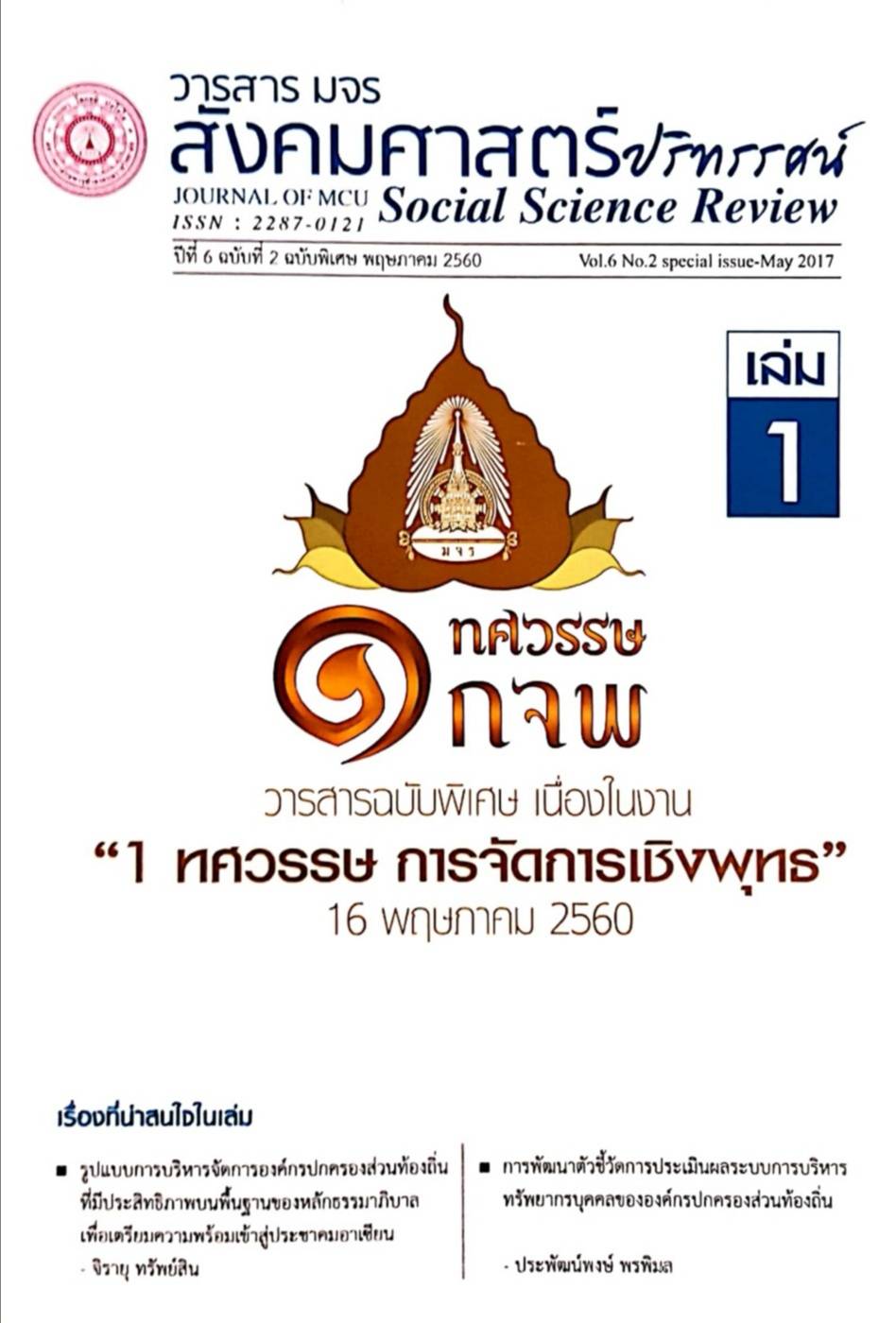ศึกษาวิเคราะห์แนวคิดเรื่องพรหมันในปรัชญาเวทานตะตามทรรศนะ พุทธปรัชญาเถรวาท
คำสำคัญ:
ความหมาย ประเภทและคุณสมบัติ คุณลักษณะ และเป้าหมายบทคัดย่อ
บทความนี้มีวัตถุประสงค์ 3 ประการ คือ 1) เพื่อศึกษาแนวคิดเรื่องพรหมันในปรัชญา
เวทานตะ 2) เพื่อศึกษาแนวคิดเรื่องพรหมในพุทธปรัชญาเถรวาท และ 3) เพื่อศึกษาวิเคราะห์
แนวคิดเรื่องพรหมันในปรัชญาเวทานตะตามทรรศนะพุทธปรัชญาเถรวาท การวิจัยนี้เป็นการวิจัยเชิง
คุณภาพ ผลการศึกษาพบว่า พรหมันในปรัชญาเวทานตะ ในระยะแรกหมายถึงความรู้อันศักดิ์สิทธิ์
และประเสริฐ ต่อมาความหมายได้กลายเป็นเรื่องของปรัชญา แนวคิดพรหมันจึงกลายเป็นสิ่งแท้จริง
สูงสุด เป็นมูลการณ์ของสรรพสิ่งในโลกจักรวาล พรหมันจึงมีฐานะเป็นผู้สร้าง ผู้ปกครอง และผู้
ทาลาย เรียกว่า ตรีมูรติ พรหมันถูกแบ่งออกเป็น 2 ประเภทคือ 1) นิรคุณพรหมัน มีลักษณะแผ่
กระจายครอบคลุมจักรวาลโดยมายา 2) สคุณพรหมัน เป็นพรหมองค์เทียม ไม่ใช่ลักษณะแท้ เป็น
ความจริงขั้นสมมติ เป็นโลกบัญญัติ ส่วนนิรคุณพรหมันนั้น เป็นลักษณะแท้ เป็นความจริงขั้นปรมัตถ์
พรหมันมีคุณลักษณะ 3 คือ สัต จิต อานันทะ ปรัชญาเวทานตะได้เสนอว่าบุคคลควรทาลายอวิทยา
เพื่อเข้าถึงพรหมันกลายเป็นเอกีภาพกับพรหมัน ผลการศึกษาพบว่า พุทธปรัชญาเถรวาทได้ปรับ
ความหมายคาว่าพรหมใหม่ใช้ในเชิงคุณธรรม หมายถึงความเจริญ ทั้งทางโลกและทางธรรม ดังนั้น
พรหมถูกจัดเป็น 2 ประเภทคือ 1) บุคลาธิษฐาน เพื่อใช้เป็นข้อเปรียบเทียบยกย่องบุคคลผู้มีพรหม
วิหารธรรม 4 คือ มี เมตตา กรุณา มุทิตา อุเบกขา 2) ธรรมาธิษฐาน เพื่อใช้เป็นหัวข้อเพื่อแสดง
ธรรมเข้าถึงพรหม อย่างไรก็ตาม หากถามว่า พรหมในพุทธปรัชญาเป็นอย่างไร ตอบว่า พรหมใน
พุทธปรัชญาก็คือเทวดาในชั้นพรหมโลก พรหมเหล่านี้เคยเป็นมนุษย์มาก่อน ด้วยอานาจแห่งการ
ปฏิบัติจนบรรลุคุณพิเศษมีฌานเป็นต้น แล้วฌานไม่เสื่อมจึงได้เกิดเป็นพรหม พรหมเหล่านั้นจึงไม่อยู่
ในฐานะเป็นพระเจ้าผู้สร้างสรรพสิ่ง ผลการวิเคราะห์วัตถุประสงค์ข้อที่ 3 พบว่า พุทธปรัชญาปฏิเสธแนวคิดพรหมันใน
ปรัชญาเวทานตะในฐานะพระเจ้าผู้สร้างโลกจักรวาล เพราะเห็นว่า พรหมยังคงเวียนว่ายตายเกิด ใน
วัฏฏะสงสารเช่นเดียวกับมนุษย์ และเห็นว่า โลกจักรวาลเป็นไปตามธรรมชาติแบบวงจรอยู่ภายใต้
กฎแห่งเหตุปัจจัยในการวิจัยพบว่า แนวคิดเป้าหมายความจริงสูงสุด (โมกษะ) ในทรรศนะปรัชญา
เวทานตะจะคล้ายคลึงกับ พระนิพพานในทรรศนะพุทธปรัชญา แต่ที่ต่างกัน คือ ความจริงสูงสุด (โมกษะ) ในปรัชญาเวทานตะเป็นแบบอัตตา ส่วนความจริงสูงสุด (พระนิพพาน) ในพุทธปรัชญาเป็น
แบบอนัตตา
เอกสารอ้างอิง
กรุงเทพฯ : โรงพิมพ์มหาจุฬาลงกรณราชวิทยาลัย.
จานงค์ ทองประเสริฐ. (2517). ศาสนาปรัชญาประยุกต์. กรุงเทพฯ : หจก.แพร่วิทยาอินเตอร์
เนชั่นแนล.
วัชระ งามจิตรเจริญ (2525). พุทธศาสนาเถรวาท. กรุงเทพฯ : มหาวิทยาลัยธรรมศาสตร.
สมัคร ปุราวาส. (2554). ปรัชญาพราหมณ์ในสมัยพุทธกาล. กรุงเทพฯ : สานักพิมพ์สยาม.
สนั่น ไชยานุกุล. (2519). ปรัชญาอินเดีย. กรุงเทพฯ : มหาจุฬาลงกรณราชวิทยาลัย.
สุนทร ณ รังสี. (2545).ปรัชญาอินเดีย ประวัติและลัทธิ. กรุงเทพฯ: จุฬาลงกรณ์มหาวิทยาลัย.
อดิศักดิ์ ทองบุญ. (2524). ปรัชญาอินเดีย. กรุงเทพมหานคร: ห้างหุ้นส่วนจากัด อรุณการพิมพ์.
Radhakrishnan S. (1966). Indin Philosophy. Vol . London : Gesrge Allen & Unern Ltd.
Samkara. (1973). “Quoted In A Source Book Inindian Philosophy. Ed. Sarvepalli
Radhakrilrishnan End Charles Amoore. Princton : Princton Univeresity
Press.
SatiChandra Chatterjee, m.a., ph.d. and Dhirendramohan data, m.a. (1984). Ph.d. An
Introduction to indian philosoph., university of Calcutta.
Svami Sarvananda. (1995) Kena Upanisad. Madras : Sri Ramakrishna Printing Press.
T. M.P. Mahadeven. (1969). The Philosophy of Advaita. Madras : Ganesh & co . Private Ltd.
Vergilius Ferm. (1971). “Monism,” Dictionary of Philosophy, Ed. Dagoert D. Runes
.Totawa : ittlefi, Adams & Co.
ดาวน์โหลด
เผยแพร่แล้ว
รูปแบบการอ้างอิง
ฉบับ
ประเภทบทความ
สัญญาอนุญาต
ลิขสิทธิ์ (c) 2020 วารสาร มจร สังคมศาสตร์ปริทรรศน์

อนุญาตภายใต้เงื่อนไข Creative Commons Attribution-NonCommercial-NoDerivatives 4.0 International License.
เพื่อให้เป็นไปตามกฎหมายลิขสิทธิ์ ผู้นิพนธ์ทุกท่านต้องลงลายมือชื่อในแบบฟอร์มใบมอบลิขสิทธิ์บทความให้แก่วารสารฯ พร้อมกับบทความต้นฉบับที่ได้แก้ไขครั้งสุดท้าย นอกจากนี้ ผู้นิพนธ์ทุกท่านต้องยืนยันว่าบทความต้นฉบับที่ส่งมาตีพิมพ์นั้น ได้ส่งมาตีพิมพ์เฉพาะในวารสาร มจร สังคมศาสตร์ปริทรรศน์ เพียงแห่งเดียวเท่านั้น หากมีการใช้ภาพหรือตารางหรือเนื้อหาอื่นๆ ของผู้นิพนธ์อื่นที่ปรากฏในสิ่งตีพิมพ์อื่นมาแล้ว ผู้นิพนธ์ต้องขออนุญาตเจ้าของลิขสิทธิ์ก่อน พร้อมทั้งแสดงหนังสือที่ได้รับการยินยอมต่อบรรณาธิการ ก่อนที่บทความจะได้รับการตีพิมพ์ หากไม่เป็นไปตามข้อกำหนดเบื้องต้น ทางวารสารจะถอดบทความของท่านออกโดยไม่มีข้อยกเว้นใดๆ ทั้งสิ้น





